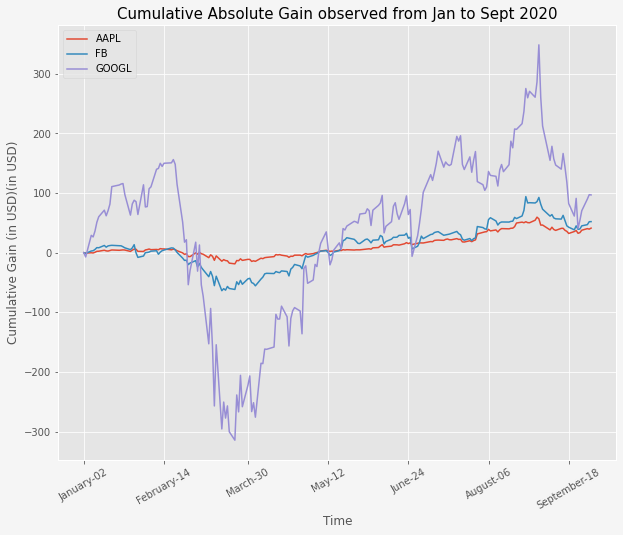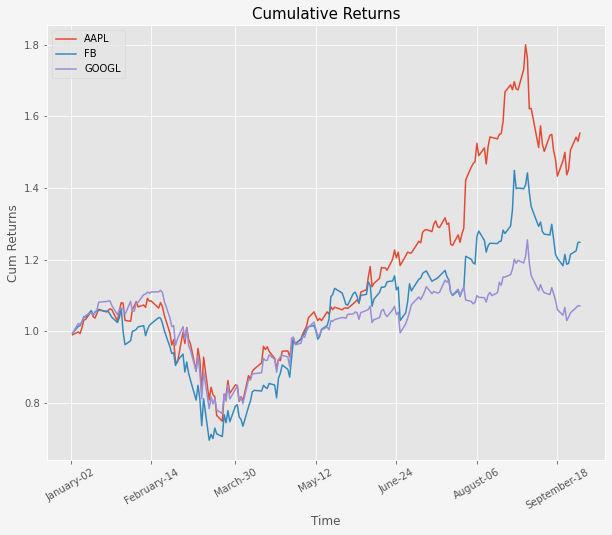Wrangling Financial Returns with Pandas
Data
The data we wish to investigate are related to three stocks quoted in the NASDAQ 100 index, namely Apple, Google and
Facebook, observed in the period Jan-Sept 2020. They are stored in three different .csv files, which
can be read and stored using the pandas .read_csv() function into aapl_df, googl_df, and fb_df, respectively.
Each of them contains different trading information on the corresponding stocks, identified by the column Symbol,
such as their trading date, represented by Date, the highest and lowest price observed in that trading session,
represented by the column High and Low respectively, the opening and closing price, represented by Open and Close,
and finally their observed Volume in each session.
A simple inspection of the first five rows of the aapl_df dataframe gives us a better idea of the data we are dealing with:
| Date | High | Low | Open | Volume | Close | Symbol | |
|---|---|---|---|---|---|---|---|
| 0 | 2020-01-02 | 75.150002 | 73.797501 | 74.059998 | 135480400.0 | 74.573036 | AAPL |
| 1 | 2020-01-03 | 75.144997 | 74.125000 | 74.287498 | 146322800.0 | 73.848030 | AAPL |
| 2 | 2020-01-06 | 74.989998 | 73.187500 | 73.447502 | 118387200.0 | 74.436470 | AAPL |
| 3 | 2020-01-07 | 75.224998 | 74.370003 | 74.959999 | 108872000.0 | 74.086395 | AAPL |
| 4 | 2020-01-08 | 76.110001 | 74.290001 | 74.290001 | 132079200.0 | 75.278160 | AAPL |
To get a general overview of the dataset under investigation, we can apply the .info()
method on the dataset:
aapl_df.info()
<class 'pandas.core.frame.DataFrame'>
RangeIndex: 189 entries, 0 to 188
Data columns (total 7 columns):
# Column Non-Null Count Dtype
--- ------ -------------- -----
0 Date 189 non-null object
1 High 189 non-null float64
2 Low 189 non-null float64
3 Open 189 non-null float64
4 Volume 189 non-null float64
5 Close 189 non-null float64
6 Symbol 189 non-null object
dtypes: float64(5), object(2)
memory usage: 10.5+ KB
This gives us a few useful information: from the columns’ type to the shape of the dataset,
so that one can easily understand the data at a glance. Note also the information related to the memory used by the
pandas.dataFrame object.
Data wrangling
We concatenate the three pandas.DataFrame objects into a single variable, and call it df_all.
That will be of type pandas.DataFrame, since we are just concatenating objects belonging to the same class.
Note that by default, the pd.concat() function concatenates the dataframe objects by row.
df_all = pd.concat([aapl_df, googl_df, fb_df])
df_all.reset_index(drop=True, inplace=True)
Note that we both reset and drop the original indexes, since rows must be uniquely determined - otherwise,
index one will be repeated thrice in df_all.
The dataset stored in df_all is a tidy dataset. We now want to perform aggregating operations with respect to
the Close price column, say creating a new pandas.DataFrame object containing as index the Date and as columns the Stock.
This is easily performed by applying the pivot() method on the df_all, which requires three arguments:
index: the column we wish to have as index of the new dataframe - in this caseDate;columns: the column we wish to have as columns of the new dataframe - in this caseSymbol;values: the column we wish to have as values of the new dataframe - in this caseClose.
The resulting dataframe is stored into the object pivot_close.
At the end, we sort the index using the sort_index() method so that we are sure the index is correctly ordered in ascending order.
pivot_close = df_all.pivot(
index='Date',
columns='Symbol',
values='Close'
).sort_index()
The first five rows of the resulting pivot_close dataframe is shown below:
| Symbol | AAPL | FB | GOOGL |
|---|---|---|---|
| Date | |||
| 2020-01-02 | 74.573036 | 209.779999 | 1368.680054 |
| 2020-01-03 | 73.848030 | 208.669998 | 1361.520020 |
| 2020-01-06 | 74.436470 | 212.600006 | 1397.810059 |
| 2020-01-07 | 74.086395 | 213.059998 | 1395.109985 |
| 2020-01-08 | 75.278160 | 215.220001 | 1405.040039 |
Now the dataset is more compact, since each row represent a trading day, and columns represents the stocks under investigation.
Data Manipulation
As an investor, we would like to know whether we are making money out of our investment.
Indeed, at the end of the day, we are happy to know the performance of the stocks in our portfolio.
We have different strategies: we might want to compute, for instance, the absolute daily change
in the stock value. This is an elementary strategy, but it is efficient to understand the trend.
To compute the difference in price with a time-window of one period (i.e. a day),
pandas provides a very interesting method called diff(): this basically computes the absolute difference in price
with respect to a time-window of size given by the argument periods, which is by default set to be one.
The following function is just a wrapper of the diff() function.
def getting_diff_price(df):
return df.diff()
absolute_diff_price_df = getting_diff_price(pivot_close)
| Symbol | AAPL | FB | GOOGL |
|---|---|---|---|
| Date | |||
| 2020-01-02 | NaN | NaN | NaN |
| 2020-01-03 | -0.725006 | -1.110001 | -7.160034 |
| 2020-01-06 | 0.588440 | 3.930008 | 36.290039 |
| 2020-01-07 | -0.350075 | 0.459991 | -2.700073 |
| 2020-01-08 | 1.191765 | 2.160004 | 9.930054 |
Sometimes, however, that information is useless. Given a book value of the investment, we would like to know whether we are making money with respect to the initial investment. The next function computes the difference between the book value and the current value of the investment - in our case, the single stock.
def getting_diff_price(df):
return df.apply(lambda x: x-x[0], axis=0)
Since we want to make our life easier, we create a method that ingests two arguments:
- date: the date we wish to measure the performance of our investment;
- data: the dataset of closing prices.
This method is provided below here:
def get_value_investment_at_date(date, data):
df = data.loc[date].to_frame().T
df.columns.name = None
return df
We call both methods in the next snippet; the results is pretty straightforward: in the given date, the stocks’ prices are all above the initial investment.
diff_from_start = getting_diff_price(pivot_close)
get_value_investment_at_date(date='2020-09-30', data=diff_from_start)
| AAPL | FB | GOOGL | |
|---|---|---|---|
| 2020-09-30 | 41.236961 | 52.119995 | 96.919922 |
The next figure describes the evolution of the investment results, given in the above dataframe diff_from_start,
into a graphical dimension.

Simple Financial Returns to the Rescue!
Can you spot a potential problem in the previous result? Well, one stock - i.e. GOOGL - is expressed in thousands,
whereas the others in hundreds.
Typically, a financial investor is more interested in looking at the financial returns rather than computing the absolute difference in price. Let \(P_{t}\) be the price of the security at time t. The simple return between times \(t\) and \(t−1\) is defined as
\[R_t = \frac{P_t}{P_{t-1}}-1\]In pandas, financial returns can be easily computed by employing the function pct_change(), which basically computes
the simple returns as described mathematically above. The following wrapper basically applies this function on each row:
def daily_change(row):
return row.pct_change()
The following object, called daily_returns, contains the simple financial returns for the three stocks.
daily_returns = pivot_close.apply(lambda x: daily_change(x))
| AAPL | FB | GOOGL | |
|---|---|---|---|
| Date | |||
| 2020-01-02 | NaN | NaN | NaN |
| 2020-01-03 | -0.009722 | -0.005291 | -0.005231 |
| 2020-01-06 | 0.007968 | 0.018834 | 0.026654 |
| 2020-01-07 | -0.004703 | 0.002164 | -0.001932 |
| 2020-01-08 | 0.016086 | 0.010138 | 0.007118 |
It looks like we have normalized the data, so that each stocks can be easily compared with another one, no matters whether it is expressed in thousands, or any other unit. Since we introduced the simple returns to better understand the investment returns, we now compute the cumulative returns, which basically mimick the logic behind the cumulative difference in price we computed in the previous section. With the only difference that the baseline is now the simple return (instead of the absolute difference in price with respect to the book value price of the investment).
def daily_cum_returns(row):
return (row + 1).cumprod()
cum_daily_returns = daily_returns.apply(lambda x: daily_cum_returns(x))
The next figure shows the cumulative returns for AAPL, FB and GGOGL.

We now clearly see that AAPL was the stock who surged the most, confirming that simple (but even log) returns should be
the starting point of any financial analyst before a deeper investigation.
Conclusions
In this post, we have understood how to employ pandas to perform exploratory financial data analysis. We have understood:
- how to manipulate a financial dataset;
- how to compute absolute difference in price;
- how to compute log returns, and the corresponding cumulative returns.
I hope you have enjoyed it. If you are interested in replicating the results shown here, you can find here the source code of this post. See you in the next post!
